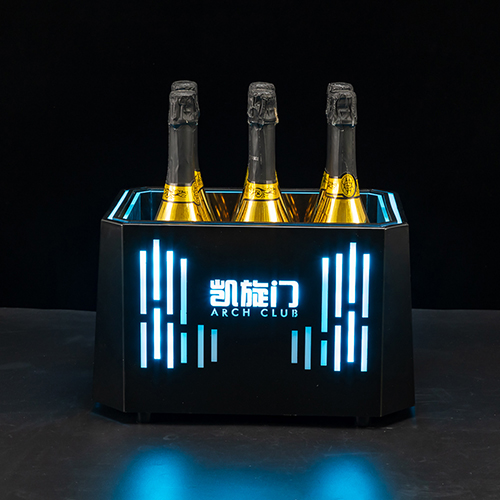E-mail: jasmine@mingxinbarnclub.com
When we choose a bottle of our favorite champagne, we expect to drink it at its best. In addition to the necessary storage conditions, the right sommelier temperature perfectly reflects the champagne's unique flavor, dense bubbles and elegant balance.
At what temperature is champagne best?
LED ice bucket supplier to share with you: the most ideal sommelier temperature for champagne is 8℃ -12 ℃, below 8℃! If the temperature of the wine is too low, the taste buds on the tip of the tongue will become numb, and the excessive acidity of the champagne will also inhibit the release of the champagne aroma.Above 12 ° c! The temperature is too high, the original fresh and energetic wine will become thick, lost the refreshing and light taste of the champagne itself, the bubbles are also easier to dissipate.
Of course, when we drink champagne, we do not need to "strictly adhere to" this principle, but should be flexible according to different types of champagne, different vintage and individual taste.In principle, the sweeter the champagne, the cooler the sommelier.
Champagne is divided by the amount of added sugar
·Brut Nature: residual sugar content < 3 g/L,
·Extra brut (super natural) : 0≤ sugar supplement quantity < 6g/L
·Brut (natural) : sugar content < 12 g/L
·Extra dry: 12 g/L≤ sugar supplement < 17 g/L
·Sec (dry) : 17 g/L≤ sugar supplement quantity < 32 g/L
· demi-sec (semi-dry) : 32 g/L≤ sugar supplement quantity < 50 g/L
·Doux (sweet) : the amount of added sugar ≥50 g/L

LED Ice Bucket
Rich, the champagne doux cocktail from chateau veuve veuve, has up to 60g/L of sugar and needs to be drunk on ice.Since the higher the sugar content, the sweeter and rounder the champagne, the lower the sommelier temperature is needed to balance the sweetness and acidity.Conversely, Brut Nature, a natural type of unsweetened champagne increasingly popular in the champagne region, is less suitable for drinking at low temperatures.The temperature is so low that the acidity is too sharp and even bitter at the end.Drinking Brut Nature champagne at the right temperature can better show the characteristics of the wine's brewing process and terroir.
The older the vintage, the more complex the champagne, the warmer the sommelier.Those that are young, fresh and simple are good to drink at low temperatures. In general, the best starting champagne without a vintage is around 8c, while more sophisticated champagnes need a higher temperature (around 10-12c) to bloom slowly.
The best sommelier temperature for a bottle of champagne, like what makes a good champagne, is never fixed.Drink at a slightly lower temperature, and enjoy the refreshing taste of the champagne and the vibrant, dancing bubbles.Slightly higher temperature to drink, feel is the wonderful evolution of champagne aroma and hierarchy, complexity.No matter what temperature, or this principle, drink happy, sharing is serious!
How to cool champagne properly:
Method 1: soak the champagne in a champagne ice bucket filled with ice water for about 20 minutes
Method 2 lay champagne flat in the refrigerator freezer about 2 hours
Refrigerator freezer temperature is about 6-8 ℃, if you want to use champagne with meals, be sure not to forget to put the wine in the refrigerator 2 hours before the meal to cool.
If it's too late to cool the champagne ahead of time, the LED ice bucket is our lazy saviour. Add ice cubes to the ice bucket, and add the same amount of water to increase the contact area with the bottle. The total volume of ice water is about 3/4 of the volume of the ice bucket. When the ice melts, it absorbs heat and cools the champagne quickly.
Essi Avellan MW says she keeps a bottle of champagne in the fridge at home in case her friends pounce, although low temperatures and unstable conditions are not suitable for storing wine.Keep in mind that you don't want to cool champagne in the freezer. Similarly, placing a champagne glass in the fridge to cool can also affect the bubbles in the glass.
Copyright © MingXin Barware Co., Limited All Rights Reserved. | Sitemap